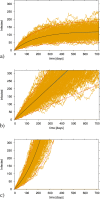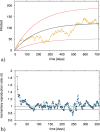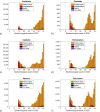Critical fluctuations in epidemic models explain COVID-19 post-lockdown dynamics
- PMID: 34226646
- PMCID: PMC8257671
- DOI: 10.1038/s41598-021-93366-7
Critical fluctuations in epidemic models explain COVID-19 post-lockdown dynamics
Abstract
As the COVID-19 pandemic progressed, research on mathematical modeling became imperative and very influential to understand the epidemiological dynamics of disease spreading. The momentary reproduction ratio r(t) of an epidemic is used as a public health guiding tool to evaluate the course of the epidemic, with the evolution of r(t) being the reasoning behind tightening and relaxing control measures over time. Here we investigate critical fluctuations around the epidemiological threshold, resembling new waves, even when the community disease transmission rate [Formula: see text] is not significantly changing. Without loss of generality, we use simple models that can be treated analytically and results are applied to more complex models describing COVID-19 epidemics. Our analysis shows that, rather than the supercritical regime (infectivity larger than a critical value, [Formula: see text]) leading to new exponential growth of infection, the subcritical regime (infectivity smaller than a critical value, [Formula: see text]) with small import is able to explain the dynamic behaviour of COVID-19 spreading after a lockdown lifting, with [Formula: see text] hovering around its threshold value.
Conflict of interest statement
The authors declare no competing interests.
Figures






References
-
- The Epidemiological SHARUCD Model Dashboard. https://wp.bcamath.org/news/en/epidemiological-sharucd-model/#introduction
-
- Grassberger P, de la Torre A. Reggeon field theory (Schlögel’s first model) on a lattice?: Monte Carlo calculations of critical behaviour. Ann. Phys. 1979;122:373–396. doi: 10.1016/0003-4916(79)90207-0. - DOI
-
- Lübeck, S. Universal scaling behavior of non-equilibrium phase transitions, Int. J. Mod. Phys. B18, 3977–4173 (also available at arXiv:cond-mat/0501259v1, updated 11. Jan. 2005). (2004).
Publication types
MeSH terms
LinkOut - more resources
Full Text Sources
Medical
Research Materials

